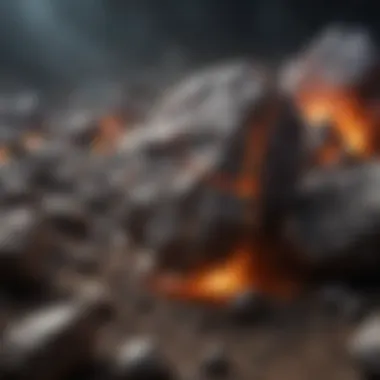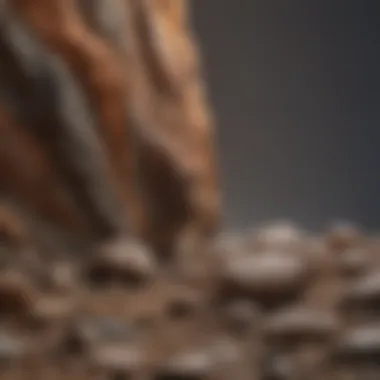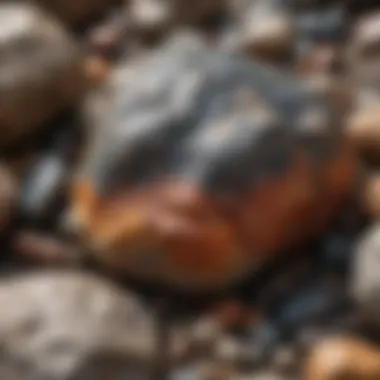Types of Rocks: An In-Depth Exploration of Earth


Intro
The study of rocks unfolds a fascinating narrative about the geological processes that have shaped our planet. Rocks are more than mere physical matter; they are records of Earth's history, encapsulating transformations that span millions of years. Understanding the types of rocks and their formation not only informs us about the Earth itself but also connects us to the past through the fossils and minerals preserved within. This exploration is particularly relevant for collectors and enthusiasts who seek to deepen their connection to the specimens they encounter.
History and Origins
Overview of Collectibles, Rocks, and Fossils
Rocks and fossils have intrigued humanity since ancient times. They contribute to our understanding of geology and paleontology. Collecting rocks can be both a hobby and a serious scientific pursuit. Each specimen tells a story of its origin and transformation through time. Many collectors appreciate the aesthetic appeal of rocks, while others seek to uncover their scientific significance.
Fossils, vital in the study of paleobiology, offer glimpses into ancient life. They preserve information on species evolution and ecosystem changes. Collectors often seek to understand the type of fossil they possess, its age, and its ecological context. This knowledge adds value to their collections, turning them into portals of history.
Historical Significance and Cultural Impact
Throughout history, different cultures have attributed various meanings and uses to rocks. In ancient civilizations, stones were not only tools but also symbols of power and spirituality. For example, the Aztecs and Mayans placed great importance on certain minerals and stones, which were believed to hold sacred properties.
In more recent history, geological discoveries have played crucial roles in shaping industry and technology. The Industrial Revolution, for instance, was significantly impacted by the mining of specific minerals and rocks. Understanding how these materials fit into cultural and historical narratives illuminates the profound impact geology has had on human development.
"Rocks contain stories written over billions of years, with each layer unfolding a part of Earth's tales."
Identification and Classification
Guide to Identifying Rocks and Fossils
Identifying rocks and fossils requires an understanding of their characteristics. Several factors come into play, including color, texture, and mineral composition. A few key identification steps include:
- Examine the appearance: Look for unique features such as layering, granulation, or fossil inclusions.
- Test hardness: Use the Mohs scale to determine hardness by scratching the rock with known minerals.
- Check for reactions: Some rocks react to acid, such as limestone, which fizzes when acid is applied.
- Evaluate weight and density: The heft of a rock can indicate its mineral content.
Common Types and Variations
Rocks are primarily categorized into three types: igneous, sedimentary, and metamorphic. Each classification has unique features:
- Igneous Rocks: Form from cooled magma or lava. They can be intrusive, like granite, or extrusive, like basalt.
- Sedimentary Rocks: Created through the accumulation of sediment. Examples are sandstone and shale, often containing fossils.
- Metamorphic Rocks: Result from alterations under heat and pressure. Notable examples include marble and schist.
Understanding these types aids collectors in organizing their specimens and appreciating their origins.
Prologue to Rocks
Rocks represent a fundamental aspect of our planet. They are more than mere formations of minerals; they tell stories of Earth's history and its dynamic processes. In this article, we will examine various types of rocks, emphasizing their formation, characteristics, and significance. The study of rocks is crucial for geologists, collectors, and anyone interested in the natural world.
Understanding rocks provides insights into how Earth works. They are categorized into three primary types: igneous, sedimentary, and metamorphic. Each type boasts distinct features shaped by different geological processes. Appreciating these differences can greatly enhance one’s understanding of our environment and the history etched in the very ground beneath us.
Additionally, this exploration allows rock collectors and enthusiasts to connect more profoundly with their specimens. Knowing the origins and properties of various rocks can deepen appreciation and inform collecting strategies.
"Rocks are the archives of Earth, revealing the history written in their layers."
We will begin the discussion by defining rocks and exploring the nature of their formation. This foundational understanding paves the way for further insights into the rock cycle and the categorization of rocks.
Igneous Rocks
Igneous rocks hold a significant place in geology and the understanding of Earth's crust. They are formed from the solidification of molten rock material, or magma, making them a key focus for those studying the processes that shape our planet. These rocks serve as a window into the geological activity that has occurred over millions of years. Understanding igneous rocks is essential for grasping the dynamic nature of Earth.
Formation of Igneous Rocks
The formation of igneous rocks occurs through the cooling and solidification of magma. This process can happen either beneath the Earth's surface, which leads to the creation of intrusive igneous rocks, or on the surface, resulting in extrusive igneous rocks. The rate at which the magma cools plays a critical role in defining the rock's texture and mineral composition.
Magma can originate from various sources, including the melting of pre-existing rocks due to high temperatures and pressures. When this magma rises towards the surface, it may lead to volcanic eruptions or can cool slowly underground. This differentiation in the cooling process accounts for the vast diversity present within igneous rocks.


Types of Igneous Rocks
Igneous rocks are primarily classified into two categories based on their formation location and characteristics.
Intrusive Igneous Rocks
Intrusive igneous rocks form when magma cools slowly beneath the Earth's surface. This slow cooling allows for the growth of larger crystals, which is a defining characteristic of these rocks. Granite is a well-known example and is favored for both its aesthetic appeal and durability. The advantage of using intrusive igneous rocks in construction is their strength and resistance to weathering. However, the downside is their formation can make them less accessible compared to extrusive types.
Key characteristics of intrusive igneous rocks include:
- Crystalline Structure: Larger crystals that are visible to the naked eye.
- Durability: High resistance to erosion and wear.
Extrusive Igneous Rocks
On the other hand, extrusive igneous rocks form when magma erupts onto the surface and cools rapidly. This rapid cooling creates smaller crystals, often resulting in a glassy texture. A common example of extrusive igneous rock is basalt. The quick formation of these rocks means they often contain gas bubbles, giving them a unique appearance. One advantage of extrusive igneous rocks is their ease of access and use in various construction materials. Yet, they tend to be less durable than their intrusive counterparts.
Key characteristics of extrusive igneous rocks include:
- Fine-Grained Texture: Small or no crystals visible.
- Lightweight: Often less dense than intrusive igneous rocks.
Textural Features
The textural features of igneous rocks vary significantly based on the cooling process. Intrusive rocks exhibit coarse-grained textures, where individual minerals can be distinguished. This is a result of the longer cooling periods allowing crystal growth. In contrast, extrusive rocks exhibit fine-grained textures or even a glassy appearance due to the rapid cooling that does not allow crystals the time to form well.
These textural features not only help with identification but also indicate the environment of formation, which is crucial for rock collectors and enthusiasts. Recognizing these differences enhances an individual's appreciation for the rocks they choose to collect.
Sedimentary Rocks
Sedimentary rocks are crucial to understanding geological history. They play a significant role in how we contextualize Earth's past and the processes that shaped its surface. These rocks tell stories of ancient environments, climates, and biological activity. Collectors and enthusiasts benefit greatly from exploring sedimentary rocks. They can find a diverse array of specimens that reflect various geological processes.
Formation Processes of Sedimentary Rocks
The formation of sedimentary rocks involves several processes. It begins with the weathering of pre-existing rocks. As these rocks break down, small particles or sediments are created. These particles get transported by wind, water, or ice to different locations. Over time, these sediments settle, accumulate, and undergo lithification. Lithification is the process where sediments become solid rock through compaction or cementation. Different conditions during these processes can affect the final properties of the sedimentary rocks.
Types of Sedimentary Rocks
Several types of sedimentary rocks exist, classified based on their formation and composition. Understanding these types is essential for both scientific study and collecting.
Clastic Sedimentary Rocks
Clastic sedimentary rocks are formed from fragments of other rocks. This aspect contributes greatly to sedimentary geology. A key characteristic of clastic rocks is their variability in particle size. Common examples include sandstone and shale.
Clastic sedimentary rocks are a popular choice for collectors due to their wide range and prevalence. They often exhibit distinct layering and can contain fossils. The unique feature of clastic rocks is their ability to preserve environmental information. Their advantages in the context of study include easy identification and broad distribution. However, some may find complexities when identifying specific types due to similarities in appearance.
Chemical Sedimentary Rocks
Chemical sedimentary rocks form when minerals precipitate from water. Their contribution to the overall study of rocks is significant. Evaporites, like rock salt, are prime examples of chemical sedimentary rocks.
A key characteristic is their formation under specific chemical conditions, often linked to high evaporation rates. This makes them beneficial in discussing ancient seawater environments. This unique feature allows them to capture specific environmental conditions, which is advantageous for understanding climatic changes. Nevertheless, they can be less common compared to clastic rocks, making them a bit more challenging to find.
Organic Sedimentary Rocks
Organic sedimentary rocks are formed from the accumulation of biological material, mainly plant debris or animal remains. Their significance lies in their ability to provide insights into past ecosystems. Coal is a well-known organic sedimentary rock.
The essential characteristic of organic rocks is their high carbon content, which reflects ancient environments rich in life. This feature makes them a beneficial choice for understanding energy resources. They provide fossil fuel sources and ecological insights. However, collectors may find these types less visually appealing than others, which can limit their collectability.
Fossils and Sedimentary Rocks


Sedimentary rocks often contain fossils, which makes them invaluable for understanding past life. Fossils are crucial for paleontological studies. They help scientists decipher evolutionary history and environmental conditions.
Many sedimentary rocks are excellent at preserving fossils due to their typically fine-grained nature. The process of fossilization favors these rocks, meaning they are often sought after by collectors. Collecting fossil-rich sedimentary rocks contributes significantly to knowledge of ancient species. This intertwines with geological research, making these rocks not just specimens but also key to broader scientific questions.
Metamorphic Rocks
Metamorphic rocks hold a unique place in geological studies, partially due to their complex formation processes and significant implications for our understanding of Earth's history. They serve as a bridge between igneous and sedimentary rocks, embodying the changing conditions of pressure and temperature deep within the Earth's crust. This exploration of metamorphic rocks reveals not just their physical properties but also their economic relevance in various industries, such as construction and art.
Definition and Formation of Metamorphic Rocks
Metamorphic rocks are formed from existing rocks that undergo transformation through heat, pressure, and chemically active fluids. This process, called metamorphism, alters the mineral structure and texture of the original rock without melting it. There are two primary types of metamorphism: regional and contact.
- Regional metamorphism typically occurs over large areas under high pressure and temperature, often associated with tectonic plate movements.
- Contact metamorphism happens when rocks are heated by proximity to molten lava or magma, resulting in localized changes.
Understanding these processes is crucial for geologists and rock enthusiasts alike, as they provide insights into the conditions present during the formation of various types of metamorphic rocks.
Types of Metamorphic Rocks
Metamorphic rocks can be categorized based on their textures and mineral compositions, leading to the identification of two primary types: foliated and non-foliated metamorphic rocks.
Foliated Metamorphic Rocks
Foliated metamorphic rocks are characterized by their layered or banded appearance, resulting from the alignment of mineral grains under directed pressure. This texture is a key aspect of these rocks, making them easily recognizable and differentiable from non-foliated types. Common examples include schist and slate.
The presence of foliation indicates the conditions in which the rock was formed, often providing information regarding the geological history of the area. These rocks offer practical benefits as they can easily split along their layers, making them suitable for a variety of construction and decorative applications.
Unique feature: Foliated rocks can be split into sheets, allowing for versatile usage.
Advantages: This characteristic enables easier handling and installation in various projects.
Non-Foliated Metamorphic Rocks
In contrast, non-foliated metamorphic rocks have a more uniform texture without distinct layers. This is usually due to the absence of directional pressure during their formation. Common examples include marble and quartzite. The lack of foliation often contributes to their structural integrity, making them particularly valued in construction.
The distinguishing characteristic of non-foliated rocks is their homogeneous appearance, resulting from mineral growth that does not align under pressure. This can lead to effective uses for areas requiring robust and visually appealing materials.
Unique feature: Non-foliated rocks display a uniform texture, which is visually striking and structurally sound.
Advantages: They are often used for countertops and flooring due to their durability and aesthetic appeal.
Metamorphic Features and Textures
The features and textures of metamorphic rocks are not only relevant for classification but also inform collectors and hobbyists about the geological history of these materials. Textures in metamorphic rocks can be fine-grained, coarse-grained, or banded, contributing to their visual and physical properties. The understanding of these characteristics enables collectors to appreciate the conditions that led to their formation.
Interestingly, metamorphic rocks often contain unique features, such as mineral foliation and granoblastic textures, which can influence a collector's choice in specimens. Those collecting for aesthetic reasons often seek out visually striking textures, while those interested in practical applications may prioritize structural characteristics. Understanding these nuances helps enthusiasts engage more deeply with their rock collections.
"Metamorphic rocks are not just relics of the past; they are active records of the Earth's dynamic processes."
Economic Importance of Rocks
Understanding the economic importance of rocks provides insight into their role in human society and industry. Various rock types serve as resources that are essential for construction, technological advancements, and even everyday products. This section explores how rocks contribute economically through their applications and the industries they support.
Rocks as Resources
Rocks are valuable resources that contribute significantly to various sectors. They are mined and processed for a range of uses:
- Construction Materials: Limestone, granite, and basalt are often used as building materials. Their durability and availability make them essential for roads, bridges, and buildings.
- Minerals and Metals: Many rocks are sources of valuable minerals and metals such as copper from porphyry deposits or gold from quartz veins. This extraction has economic implications on a global scale, influencing trade and industry.
- Aggregate: Sandstone, gravel, and other types are used as aggregate in concrete production. This is vital for infrastructure development.
- Decorative Stones: Certain rocks, such as marble and granite, are used for cosmetic purposes. They add aesthetic value to structures and are preferred in flooring and countertops.


With the ongoing urbanization and population growth, the demand for these resources will likely escalate.
Rocks and Industry
The industrial applications of rocks are extensive and varied. Several industries rely heavily on rocks for production and processes:
- Construction Industry: As mentioned, numerous rocks like granite and limestone are indispensable. The construction sector's growth relies on the sustainable mining and processing of these materials.
- Manufacturing: Rocks like gypsum are processed into plaster and drywall. This plays a key role in building interiors.
- Energy Production: Coal, a sedimentary rock, is a significant energy source. Though its use is declining due to environmental concerns, it remains crucial in some regions.
- Chemical Industry: Rocks such as phosphate rock are processed to produce fertilizers. This supports agricultural productivity and food supply.
Rocks are not only components of our environment but also instrumental in our economy, acting as foundational sources for various industries.
The interdependence between rocks and industry underscores their significance. As we continue to explore and exploit these rocks as resources, it is vital to do so sustainably to preserve the environment for future generations.
Rocks in Collecting and Hobbyist Communities
The world of rock collecting is more than just a pastime; it’s a deep-rooted community for enthusiasts, educators, and scientists alike. Collecting rocks offers insight into geological history and helps foster a profound appreciation for Earth’s natural resources. The importance of this community is multi-faceted, blending education, personal enrichment, and significant connections among individuals sharing a common interest.
One of the primary elements of rock collecting is the ability to identify different types of specimens. Each rock can tell a unique story of its origin, formation, and journey through geological time. Collectors often use this knowledge to enhance their collections, making every piece significant, not merely in terms of aesthetics or monetary value, but also by contributing to a broader understanding of geology.
Identifying Rocks for Collectors
Identifying rocks accurately is essential for collectors aiming to build a meaningful collection. There are various tools and methods that can aid in this process:
- Visual Characteristics: Observing color, texture, and grain can provide a lot of information. Igneous rocks often appear crystalline, while sedimentary rocks may show layering.
- Hardness Testing: Using a simple Mohs hardness scale can help determine a rock's identity. This practice involves scratching the rock against different materials to see which ones leave a mark.
- Field Guides and Apps: Many enthusiasts utilize field guides tailored for rock identification or mobile apps that can help quickly categorize finds on the go.
Engaging online communities, such as those found on Reddit, can also be beneficial. Asking for advice from fellow collectors or sharing pictures can lead to more accurate identifications.
Caring for Rock Collections
Caring for rock collections extends beyond simple storage. Proper maintenance ensures the preservation of each specimen’s features and enhances their durability. Here are some best practices:
- Storage: Rocks should be stored in a cool, dry place away from direct sunlight. Individual compartments or boxes will prevent scratching and minimize damage.
- Cleaning: Only clean rocks when necessary. For most, a gentle rinse under water will suffice. Avoid harsh chemicals that could affect the surface.
- Documentation: Maintaining records that include the origin, type, and any unique features of each rock adds value to the collection. Consider labeling each specimen in a way that reflects these details.
By taking the time to care for their collections, hobbyists not only preserve their own findings but also contribute to a broader understanding of geology for future generations.
"Each rock tells a story, and as collectors, we become storytellers, preserving the tales of Earth's past in our collections."
End
The conclusion of this article serves as a critical synthesis of the insights gained throughout the exploration of rocks. It is essential in reinforcing the significant roles that the three types of rocks—igneous, sedimentary, and metamorphic—play in both our natural world and the broader context of geological sciences. By summarizing the formation processes, characteristics, and economic importance, the conclusion offers clarity and perspective on the cumulative knowledge presented.
Understanding rock types allows for a deeper appreciation of Earth’s history and the dynamic processes that shape it. For collectors and enthusiasts, the conclusions drawn here emphasize the profound connections they may form with their specimens. Each rock tells a story, revealing not only its own origin but also its relevance to larger geological phenomena.
"Rocks are more than just natural objects; they are the archives of our planet's geological past, holding secrets of formation, evolution, and environmental changes."
This section also highlights the importance of further research and study in this field, as ongoing exploration will undoubtedly yield new insights and discoveries. As methods improve and technology advances, our understanding of rocks and their implications is likely to evolve, leading to more refined categorization, analysis, and applications in various disciplines.
Reflections on Rock Types
In reflecting on rock types, one recognizes the diversity and complexity inherent in geological formations. Each category—igneous, sedimentary, and metamorphic—presents unique properties and formation processes. Igneous rocks, born from molten material, encapsulate the dynamic origins of Earth’s crust. They vary remarkably, from the coarse granites formed slowly underground to the fine-grained basalts that cool rapidly at the surface.
Sedimentary rocks, on the other hand, emerge from the accumulation of sediment over time, recording layers of history. They often contain fossils, offering a window into past life and environments. The study of these rocks is crucial for understanding paleoecology and geological timelines.
Metamorphic rocks showcase the transformative power of heat and pressure, which alter existing rocks into new forms. These changes can involve significant physical and chemical alterations. Collectors will find interest in the beautiful textures and patterns that result from the metamorphic processes.
Future Directions in Rock Studies
The field of rock studies is continually evolving, driven by advancements in technology and research methodologies. Future directions may involve increased use of remote sensing technologies, which allow geologists to survey landscapes and identify rock formations with greater efficiency. This could lead to new discoveries of previously unrecognized rock types or formations.
Additionally, interdisciplinary studies combining geology, biology, and environmental science can yield a richer understanding of how rocks influence ecosystem functions and vice versa. Understanding rock weathering processes can also provide insights into soil formation, which is vital for agriculture and habitat preservation.
The emergence of 3D modeling software is also changing how researchers visualize and interpret geological data. Enhanced visualization can improve teaching methods, making geology more accessible to a broader audience, including budding rock collectors and enthusiasts.
As knowledge expands, it is essential to share findings with the collector community and the general public. This can foster appreciation and encourage more people to engage with the study of rocks, promoting a culture of curiosity and conservation.



